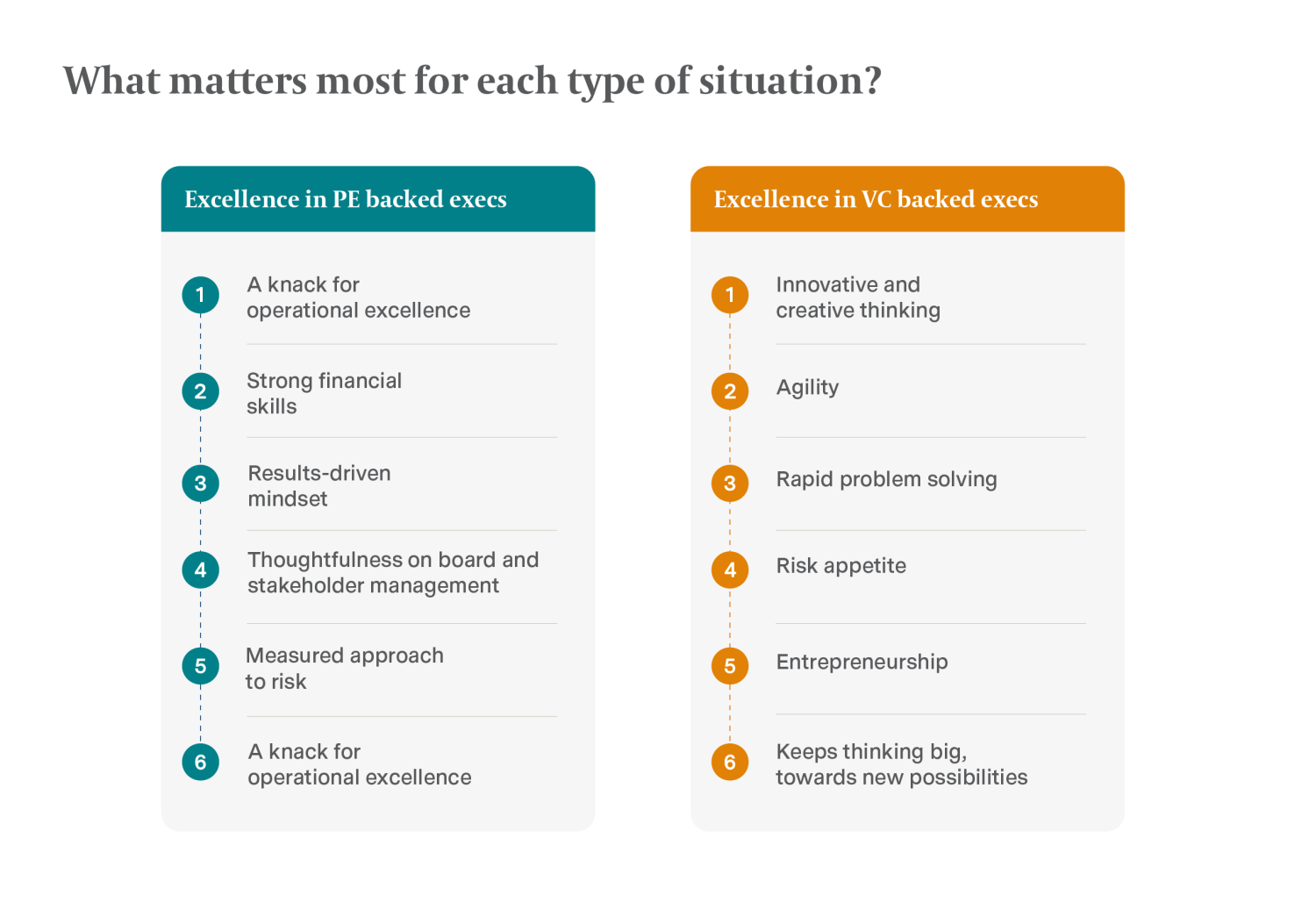On several levels, private equity (PE) and venture capital (VC) present a continuum of funding models and philosophies. When it comes to talent, however, we have found that for executives to succeed in one versus the other, they often need to operate in very different worlds, each with unique priorities that shape their strategies and values. Some executives do successfully navigate both environments, adapting their skills to thrive in each setting. Overall, it is essential to recognize the differences upfront, especially for those considering a move between PE and VC, as well as for hiring managers looking to build strong leadership teams. By understanding these key differences, professionals will be able to better leverage their experiences for maximum impact, whether they're in a rapidly evolving startup or a portfolio company of a mature investment firm.
- Focus on financial performance: PE backed executives need to be well versed in financial metrics, cash flow, and profitability right from the start, as they usually aim to see returns within about 3 to 7 years. On the flip side, VC firms prioritize growth potential, often accepting early losses to scale quickly and capture market share; therefore, there tends to be less of a premium placed on broader financial savvy beyond the CFO and COO positions.
- Operational efficiency: There can be a fundamental difference between growth and optimization between VC and PE. Even in a growth PE scenario, there is a high premium placed on executives who can foster sustainable and efficient growth. VCs, however, tend to focus on developing products and finding a good market fit, with less immediate pressure to optimize existing operations.
- Strategic planning: In the PE world, executives typically are in charge of existing product lines, and they then prioritize creating detailed plans that align with their firm’s goals, often involving big changes like restructuring. Meanwhile, VC executives take a more flexible approach, adjusting their strategies based on market feedback and what customers are saying.
- Stakeholder management: PE executives must stay closely engaged with their board and investors, providing regular updates and keeping a firm grip on oversight. The PE investor, whether majority or minority, is a critical stakeholder to engage. By contrast, VC representative board members tend to sit on a lot of boards, have a minority stake, and may be less closely connected with the detailed operations of the business. They are still a valuable stakeholder and under-managing this relationship can be a mistake, but executives tend to have more leeway to experiment while also building relationships with a wider range of people, including customers and mentors.
- Appetite for risk: There is a big difference here as PE executives tend to be more risk-averse, focusing on managing risks related to investments and operational changes. VCs, however, embrace risk tied to innovation and market entry, understanding that failure can be part of the journey.
- Timeline: PE firms typically have a fixed time window by which they plan to exit their investment. These executives plan for shorter investment horizons, which means they need to act quickly and make decisive moves. In VC, by contrast, the time horizon varies and can actually shift quickly, depending on the market environment and the state of the specific investment versus the rest of the portfolio. In some circumstances, they extend a lot of patience for the big bet, while in others there is a push for a bit bet or break.
- Culture and team structures: PE firms often emphasize a high-performance culture with clear accountability, while VC firms promote a dynamic and collaborative environment that encourages creativity and quick decisions.
- Market positioning: PE executives focus on maximizing the value of what they already have, often through mergers and acquisitions. VCs, on the other hand, aim to disrupt the market, targeting underserved niches or even creating new markets altogether.

Hiring Considerations: Moving Between PE and VC
When thinking about hiring an executive from a VC-backed organization into a PE setting (or vice versa), it is essential to consider the different experiences and mindsets these candidates bring.
For a VC executive, the value lies in their breadth of experience and adaptability. They thrive in environments that are still evolving, where change is constant, and innovation is key. Their ability to pivot and respond to market feedback can be a significant asset in dynamic situations. Hiring managers should look for candidates who can navigate uncertainty and bring fresh ideas, as these skills can greatly benefit a PE-backed firm looking to explore new growth avenues or market segments.
When hiring for a PE-backed organization, the emphasis shifts to proven success and delivery. Here, the track record of achieving results is paramount. Hiring managers should prioritize candidates with specific functional expertise and experience in optimizing operations, managing risks, and implementing strategic initiatives. In this environment, breadth and agility are often less critical; what matters most is the ability to execute effectively and contribute to the firm’s financial goals. Many candidates will have achieved these types of successes in the venture backed startup world – these are the ones who will thrive in PE as well.
Ultimately, hiring managers should think about the unique strengths and experiences of each candidate in the context of their organization's needs. Recognizing these differences can lead to more informed hiring decisions and ultimately strengthen the leadership teams in both PE and VC environments.





